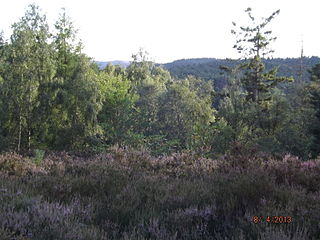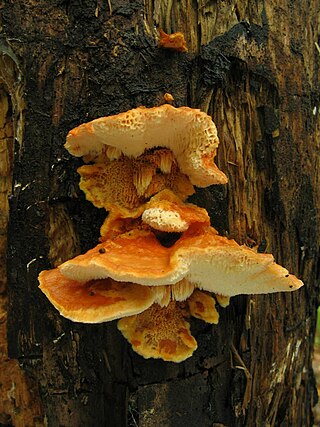
Junghuhnia is a genus of crust fungi in the family Steccherinaceae. It was circumscribed by Czech mycologist August Carl Joseph Corda in 1842. The generic name honours German-Dutch botanist Franz Wilhelm Junghuhn.

Friedrich Franz Wilhelm Junghuhn was a German-born Dutch botanist and geologist. His father, Friedrich Junghuhn was a barber and a surgeon. His mother was Christine Marie Schiele. Junghuhn studied medicine in Halle and in Berlin from 1827 to 1831, meanwhile (1830) publishing a seminal paper on mushrooms in Linnaea. Ein Journal für Botanik.

Muir of Dinnet is a national nature reserve (NNR) situated close to the village of Dinnet in Aberdeenshire, Scotland. The reserve extends 1166 hectares from the River Dee to Culbean hill, and encompasses a wide range of habitats including dry heath, raised bog, woodland, and two lochs: Loch Kinord and Loch Davan. Muir of Dinnet was first declared a NNR in 1977 due to its value as a habitat for flora and fauna, and its important geomorphological features, the most striking of which is the Burn O'Vat. Muir of Dinnet is owned by Dinnet Estate and managed by NatureScot, who provide a visitor centre and a range of other facilities including waymarked paths and a car park. As of 2012 it was estimated that approximately 40,000 people visited Muir of Dinnet each year.

The Steccherinaceae are a family of about 200 species of fungi in the order Polyporales. It includes crust-like, toothed, and poroid species that cause a white rot in dead wood.

Irpex is a genus of corticioid fungi in the order Polyporales. Species produce fruit bodies that grow as a crust on the surface of dead hardwoods. The crust features an irpicioid spore-bearing surface, meaning it has irregular and flattened teeth. Irpex is distinguished from the similar genera Junghuhnia and Steccherinum by the simple septa found in the generative hyphae.

Steccherinum is a widely distributed genus of toothed crust fungi in the family Steccherinaceae.

František Kotlaba was a Czech botanist and mycologist.
Zignoëlla is a genus of fungi within the Chaetosphaeriaceae family.

In Finland, Kotiranta and Niemelä introduced a widely used method for comparing the conservation values of different forest areas, based on the observation that certain wood-rotting fungi are very sensitive to the impact of human activities on forest ecosystems. Such species are slow to return to areas from where they have disappeared, so their presence is evidence of a long continuity in forest ecosystems.
Skeletocutis biguttulata is a species of poroid fungus in the family Polyporaceae. It was first described scientifically by Swedish mycologist Lars Romell in 1932. Tuomo Niemelä redescribed and illustrated the fungus in 1998, and explained that collections of this fungus had previously been attributed to the related Skeletocutis subincarnata. S. biguttulata may be distinguished from the latter fungus by its biguttulate spores, more regularly arranged pores, and the cracking pore surface seen in older specimens.

Junghuhnia nitida is a widespread species of crust fungus in the family Steccherinaceae.
Junghuhnia africana is a species of crust fungus in the family Steccherinaceae. The type specimen was collected in Bwindi Impenetrable National Park, Uganda, growing on a rotting hardwood log. Its ellipsoid spores measure 5–6 by 4–4.5 µm. The fungus was described as new to science in 2005 by mycologists Perpetua Ipulet & Leif Ryvarden.
Junghuhnia kotlabae is a species of crust fungus in the family Steccherinaceae. It was described as a new species by Czech mycologist Zdenek Pouzar in 2003. The fungus, found in Cuba, was collected from a fallen stem of the Cuban royal palm. Distinguishing characteristics include the effuso-reflexed fruit bodies, broad spores, and two types of cystidia.
Junghuhnia glabricystidia is a species of crust fungus in the family Steccherinaceae. The type specimen was collected in Kibale National Park, western Uganda, growing on a rotting hardwood log. The crust-like fruit bodies of the fungus measure up to 1 cm wide, 3 cm long, and 3 mm thick. The pore surface is white to cream, with round pores numbering 4 to 5 per millimetre. The tube layer, which is the same colour as the pore surface, is up to 2 mm deep, with a 1-mm thick subiculum. Its ellipsoid spores measure 4–5 by 3–3.5 µm. The fungus was described as new to science in 2005 by mycologists Perpetua Ipulet & Leif Ryvarden.
Junghuhnia chlamydospora is a species of poroid crust fungus in the family Steccherinaceae. The type specimen was collected in the Cockscomb Basin Wildlife Sanctuary in Belize, growing on a dead standing tree. The crust-like fruit bodies of the fungus measure up to 2 millimetres (0.079 in) thick and have an ochraceous margin. The pore surface is yellowish to discoloured when fresh, later becoming blackish in parts when dry. The angular pores number 2 to 3 per millimetre. The tube layer, which is the same colour as the pore surface, is up to 3 millimetres (0.12 in) deep. Its cylindrical spores measure 4–4.5 by 1.5–2 µm. It has finely encrusted skeletal hyphae, similar to the related Saint Lucian fungus J. carneola. The abundant chlamydospores, for which J. chlamydospora is named, measure 8–12 by 4–6 µm and are strongly dextrinoid. The fungus was described as new to science in 2007 by mycologist Leif Ryvarden.
Junghuhnia japonica is a species of poroid crust fungus in the family Steccherinaceae. The type specimen was collected in Ōkuchi, Japan, growing on a rotting log of Castanopsis. The fungus is only known from the type locality. Its cylindric spores measure 4–5 by 2–2.4 µm and are smooth and hyaline. J. japonica has two types of cystidia. One type is thick walled and heavily encrusted, measuring 40–70 by 9–15 µm. The other type is tubular, smooth, and thin walled, measuring 20–35 by 4–8 µm. The latter type, which have an oily or granular appearance under the microscope, are known as gloeocystidia.
Skeletocutis albocremea is a species of poroid fungus in the family Polyporaceae. It was described as new to science by Alix David in 1982. It was reported as new to Russia in 2004.
Junghuhnia globospora is a species of poroid fungus in the family Steccherinaceae. Found in the Andes region of Venezuela, it was described as a new species in 2010 by mycologists Teresa Iturriaga and Leif Ryvarden.
Butyrea luteoalba is a species of fungus belonging to the family Steccherinaceae.
Melanothamnus is a genus of red algae belonging to the family Rhodomelaceae.







